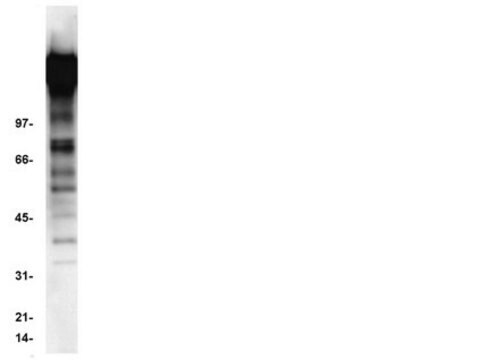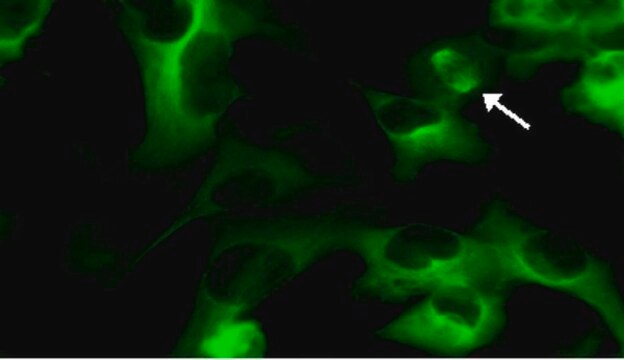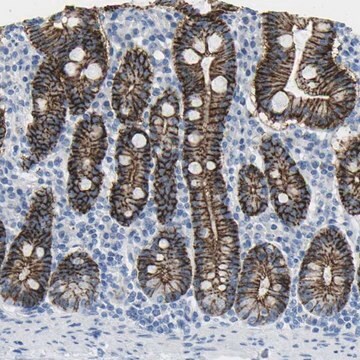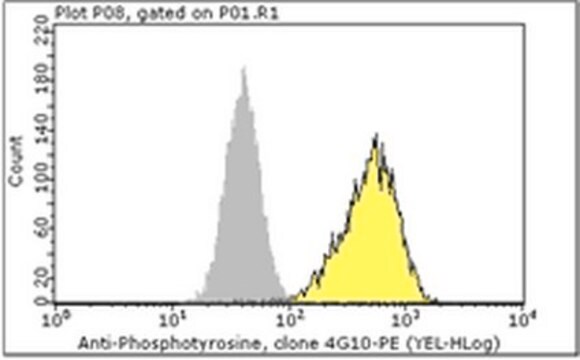16-199
Anti-Phosphotyrosine Antibody, recombinant clone 4G10®, agarose conjugate
clone 4G10®, Upstate®, from mouse
Sign Into View Organizational & Contract Pricing
All Photos(1)
About This Item
UNSPSC Code:
12352203
eCl@ss:
32160702
NACRES:
NA.41
Recommended Products
biological source
mouse
Quality Level
antibody form
purified antibody
antibody product type
primary antibodies
clone
4G10®, monoclonal
species reactivity
human
manufacturer/tradename
Upstate®
technique(s)
immunoprecipitation (IP): suitable
shipped in
wet ice
target post-translational modification
phosphorylation (pTyr)
Gene Information
human ... PID1(55022)
General description
Some of the tyrosine residues can be tagged with a phosphate group (phosphorylated) by protein kinases. (In its phosphorylated state, it is referred to as phosphotyrosine.). Tyrosine phosphorylation is considered as one of the key steps in signal transduction and regulation of enzymatic activity. The advent of anti-phospho-tyrosine antibodies is one of significant events in signal transduction research. Before the availability of anti-phosphotyrosine antibodies, tyrosyl phospyhorylation of proteins and enzymes was investigated through hazardous and time-consuming radioactive experiments. Anti-phosphotyrosine antibodies are commonly used in western blots after the targeted proteins have been immunoprecipitated to measure the tyrosyl phosphorylation of the proteins. Anti-phosphotyrosine antibodies are also directly used on cell lysate to examine the overall change of tyrosine phosphorylation level in reponse to various treatments.
Specificity
Recognizes tyrosine-phosphorylated proteins from all species.
Application
Anti-Phosphotyrosine Antibody, recombinant clone 4G10, agarose conjugate detects level of Phosphotyrosine & has been published & validated for use in IP.
Research Category
Signaling
Signaling
Research Sub Category
General Post-translation Modification
General Post-translation Modification
This product is useful for immunoprecipitation and immunoaffinity chromatography methods.
Features and Benefits
Format: Gel Immobilized
Quality
Routinely evaluated by immunoprecipitating the EGF receptor and other tyrosine phosphorylated proteins from EGF-stimulated A431 cells.
Immunoprecipitation Analysis:
10 μL of this lot immunoprecipitated the EGF receptor and other tyrosine phosphorylated proteins from EGFstimulated A431 cells.
Immunoprecipitation Analysis:
10 μL of this lot immunoprecipitated the EGF receptor and other tyrosine phosphorylated proteins from EGFstimulated A431 cells.
Target description
Dependent upon the molecular weight of the tyrosine phosphorylated protein being detected.
Physical form
Gel Immobilized mouse monoclonal antibody covalently coupled to protein A agarose beads and provided as a 50% slurry suspended in PBS, containing 0.01% Kathon, as a preservative for a total volume of 2 mL. Liquid suspension.
Protein A purified
Storage and Stability
Stable for 6 months at 2-8ºC from date of receipt.
Analysis Note
Control
Pervanadate-treated human A431 cell extracts, EGF-treated human A431 cells.
Pervanadate-treated human A431 cell extracts, EGF-treated human A431 cells.
Other Notes
Concentration: Please refer to the Certificate of Analysis for the lot-specific concentration.
Legal Information
4G10 is a registered trademark of Upstate Group, Inc.
UPSTATE is a registered trademark of Merck KGaA, Darmstadt, Germany
Disclaimer
Unless otherwise stated in our catalog or other company documentation accompanying the product(s), our products are intended for research use only and are not to be used for any other purpose, which includes but is not limited to, unauthorized commercial uses, in vitro diagnostic uses, ex vivo or in vivo therapeutic uses or any type of consumption or application to humans or animals.
Not finding the right product?
Try our Product Selector Tool.
Storage Class
12 - Non Combustible Liquids
wgk_germany
WGK 1
flash_point_f
Not applicable
flash_point_c
Not applicable
Certificates of Analysis (COA)
Search for Certificates of Analysis (COA) by entering the products Lot/Batch Number. Lot and Batch Numbers can be found on a product’s label following the words ‘Lot’ or ‘Batch’.
Already Own This Product?
Find documentation for the products that you have recently purchased in the Document Library.
Xiquan Liang et al.
Journal of the American Society for Mass Spectrometry, 18(11), 1932-1944 (2007-09-18)
Protein phosphorylation regulates many aspects of cellular function, including cell proliferation, migration, and signal transduction. An efficient strategy to isolate phosphopeptides from a pool of unphosphorylated peptides is essential to global characterization using mass spectrometry. We describe an approach employing
Our team of scientists has experience in all areas of research including Life Science, Material Science, Chemical Synthesis, Chromatography, Analytical and many others.
Contact Technical Service







